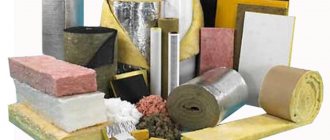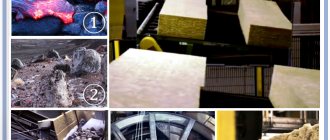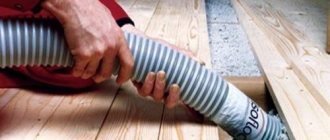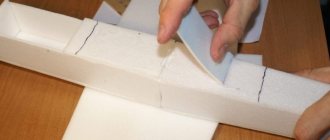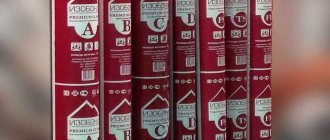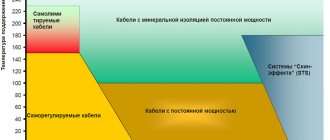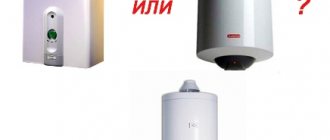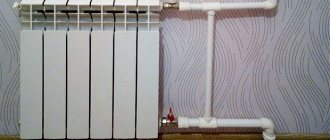What is polyurethane foam and what does it come in?
This material is a type of plastic. It has a cellular foam structure, and the composition of polyurethane foam is dominated by a gaseous substance - from 85 to 90 percent. Numerous tiny cells, isolated from each other, are filled with gas. The remaining few percent of the volume is the solid part - the thin walls of these cells.
Polyurethane foam was invented by German scientists from the company IG Farben, led by the famous Otto Bayer. However, in those days this name was not yet popular. So, in the laboratory of the city of Leverkusen, after a series of experiments, a new material was obtained, the properties of which turned out to be unique. It became clear that this substance had a lot of potential applications.
Various types of polyurethane foam are in great demand today - after all, they are very simple to produce, and right away on the construction site. In this case, the two liquid components, when mixed, enter into a chemical reaction. If the required proportions are observed, a polymer is synthesized, which is a hardened foam. By modifying the preparation recipe, you can obtain polyurethane foams that differ in properties from each other. Some of them are suitable for thermal insulation of windows and doors, others for insulating houses made of brick or reinforced concrete, and still others for a variety of pipelines.
Video. The process of producing polyurethane foam
So, depending on the proportion of the starting substances, we obtain polyurethane foams with cells of different sizes, the walls of which have different thicknesses and, accordingly, strength. We will not list all types of polyurethane foam that can be obtained by changing the recipe. Let's look at the two most popular materials of this group.
1. The familiar foam rubber, scientifically called elastic polyurethane foam, has a density of 5 to 35 kilograms per cubic meter. We encounter this material every day in the form of washcloths and sponges, filling in chairs and sofas, lining in shoes and clothes, as well as shockproof packaging.
2. Rigid polyurethane foam has recently begun to be used in construction work. But today scientists can already say what will happen to it in 30 or 50 years - the material is being studied and tested. In addition, some laboratories conducted experiments in which polyurethane foam was subjected to an artificial aging procedure. Both the results turned out to be the same.
It is safe to say that polyurethane foam does not like contact with mineral acids and organic solvents. But he is not at all afraid of water and oil products.
In our country we use a fairly large number of brands of rigid polyurethane foam – about 30. They are used both individually and in various combinations with each other. It all depends on the purpose of the application - it could be insulating a house, protecting it from noise, or creating an insulating layer on refrigeration equipment. This material has received such wide application possibilities due to its wonderful properties.
Spraying polyurethane foam on the insulated surface.
Chemical structure
For the addition reaction to occur and the formation of polymer chains, the presence of at least two different components is necessary: a polyol and a polyisocyanate.
The reaction itself takes place in several stages. First, bifunctional isocyanate molecules with a group (–N═C═O) and hydroxyl groups (–OH) are formed from a diol and a diisocyanate.
As a result of the chain reaction, short chains of structurally identical and homogeneous polymers are formed at both ends of the molecular groups, which can be polymerized with other monomers.
Polyol addition reaction
A small amount of water is added to the reaction mixture, and as a result of the reaction with part of the isocyanate groups, carbon dioxide is formed, which is the main factor in foaming.
At the same time, the primary amino group reacts with the isocyanate to replace the urea, thereby achieving chain stability.
Reaction of polyisocyanates with water
Depending on the chain length of gas-filled microgranules, the mechanical properties of polyurethane also differ.
Thus, the typical density is from 5 to 40 kg/m³ for soft foam blocks, which are widely used as various types of furniture fillers, etc.
Rigid polyurethane foams, with a density from 30 to 86 kg/m³, are widely used in construction as a heat-insulating and sound-proofing material.
About the technical characteristics of polyurethane foam
We will talk about rigid polyurethane foams - they are used during construction work. They retain heat excellently, practically do not allow steam and water to pass through, and are not afraid of corrosion, radiation and aggressive chemical environments. In addition, they are very durable and can withstand large temperature changes and weather disasters.
Thermal conductivity of polyurethane foam
The properties of polyurethane foam as a heat insulator depend on the size of its constituent cells. The thermal conductivity of rigid polyurethane foams ranges from 0.019 to 0.035 watts per meter per Kelvin. To make it clear that this is an excellent indicator, here are examples of comparison. For expanded clay gravel, this parameter ranges from 0.12 to 0.14 watts per meter per Kelvin, and for gas glass and foam glass - as much as 0.84 watts per meter per Kelvin. Inferior to polyurethane foam are mineral wools with a thermal conductivity of 0.045-0.056 watts per meter per Kelvin.
Noise-absorbing ability of polyurethane foam
The absorption of noise by a material is determined by several parameters: elasticity, ability to pass air, as well as the thickness of the insulation and its damping properties. So, for polyurethane foam, the ability to block sounds depends on how rigid the material frame is and what the frequency of sound vibrations is.
The friction force that occurs when particles are transferred between adjacent cells is also important, as is the absorption of sound waves by air from the cells. Through experiments, it was found out that semi-elastic polyurethane foam protects best from noise.
Relation to chemical environments
Polyurethane foam is more resistant to aggressive chemicals than polystyrene foam. Polyurethane foam cannot destroy caustic chemical vapors (the concentration of which does not exceed the permissible limit). This insulation is not afraid of gasoline, oils, alcohols, diluted acids and plasticizers. He is quite resistant to esters with ketocacs. Even concentrated acid is not always capable of damaging it.
If you apply a layer of polyurethane foam to a metal surface, it will not rust. After all, in this case, triple protection will work - both the polyurethane itself and two films, outside and inside, resulting from the polymerization of the material. One of the films will be adjacent to the metal, and the second will be in contact with the external environment. Depending on the brand of polyurethane foam, the protective layer may be more or less effective.
Moisture absorption of polyurethane foam
The moisture absorption of this material is one of the lowest - per day it can reach from 1 to 3 percent of the original volume. This indicator depends on the recipe for preparing PU foam. The denser the insulation, the less water it can absorb. Special substances introduced into the composition of polyurethane foam also increase water resistance. One of these water repellents, which reduces moisture absorption by 4 times, is regular castor oil.
Flammability of polyurethane foam
Polyurethane foams can belong to three groups: C (self-extinguishing), TC (hard to burn) and TV (hard to ignite). As you can see, the flammability of polyurethane foam is quite low. And either the introduction of special additives or changing the chemical formula of the recipe helps to increase its fire resistance. The second option is expensive, so the method of introducing fillers is more often used.
These can be phosphorus compounds, as well as halogens. You can apply only a thin layer of fire-resistant polyurethane foam containing additives to ordinary polyurethane foam. In industrial premises where the risk of fire is high, such a coating applied in two layers would be quite appropriate.
Video. Does polyurethane foam burn - flammability test
Density of polyurethane foam
The density of this insulation varies from 30 to 80 kilograms per cubic meter. This indicator directly depends on what technology was used in the production of the material. In principle, this is not bad - when insulating, both harder and softer materials may be required. It all depends on the specific task. Therefore, sometimes you can get significant savings by using cheaper polyurethane foam of lower density.
Durability of polyurethane foam
The service life of polyurethane foam is declared by manufacturers to be no less than 20-30 years. But there is already evidence that the real numbers are much higher. In American, German, Swedish and Japanese cities, buildings built in the seventies of the last century are now being dismantled. During their construction, polyurethane foam was used for insulation.
Having studied its samples taken from pipes, walls and roofs, experts concluded that the material remained unchanged in all respects. Nine-tenths of all cells remain insulated, allowing for continued heat conservation. The chemical state also did not change. Both laboratory and industrial tests confirm this in unison.
Environmental safety and impact on humans
After 10 - 20 seconds, during which the material hardens, polyurethane foam becomes absolutely safe. If it is heated to a temperature of more than 500 degrees, the release of two gases will begin: carbon dioxide and carbon monoxide. But if you put wood or rubber in place of polyurethane foam, then at the same temperature they will turn out to be more dangerous. Experiments on mice confirmed this.
Flammability of polyurethane foam in a fire
According to GOST 30244–94, wood or polymer-based materials are flammable. Polyurethane foam is a material with a low flammability class. By type of flammability there are:
G1 - slightly flammable.
This type of polyurethane foam does not burn, is resistant to fire, but can lose weight when exposed to fire.
G2 - moderately flammable.
Does not support combustion, goes out on its own.
G3 - normally flammable.
In the absence of flame it goes out on its own.
G4 - highly flammable.
Burns quickly and may become a source of fire.
Numerous tests carried out confirm the fire safety of polyurethane foam. On the company’s website you can find components for polyurethane foam with different types of flammability: from G1 to G3. "Khimtrast SKN-30/141 G3" - normally flammable, used for seamless thermal insulation of walls, attics, and attics. Low-flammable materials include Khimtrust SKN-60 G1, which is used for insulation of pipelines, refrigerators, and buildings.
Mineral wool also does not burn, but releases formaldehyde into the atmosphere. Expanded polystyrene has a flammability class of G4: it is easily flammable, burns completely, and when smoldering it has a characteristic pungent odor. Polystyrene foam is inferior to polyurethane foam in terms of fire safety. Please note that combustion products of any material can be toxic. This depends on the composition, as well as how long it takes to fade.
Polyurethane foam properties table
| Options | Minimum and maximum values |
| Thermal conductivity, W/m per Kelvin | 0,019 — 0,035 |
| Density, kg/m | from 26 to 300 |
| Stress at which the material begins to fail, MPa | in compression from 0.15 to 1.0 in bending from 0.35 to 1.9 |
| Water absorption,% of volume | from 1.0 to 5.0 |
| Material flammability group | GOST-12.1.044 (low-flammability) |
Comparison of polyurethane foam with other types of insulation
In order to find out how justified and advisable the use of polyurethane foam as insulation is, its main physical and technical parameters should be considered in comparison with other popular materials, for example mineral wool:
| Indicators | Units | Name of material | |
| Polyurethane foam (PPU) | Mineral wool | ||
| Coefficient of thermal conductivity | W/m K | 0,033 | 0,049 |
| Apparent density | Kg/m3 | 60-80 | 55-150 |
| Compressive Strength | MPa | 0,3 | Not standardized, minimal load resistance |
| Moisture absorption, no more | % | 10 | Not standardized, constant percentage of humidity 4%, low resistance to moisture |
| Effective service life, not less | years | 40 | 10 |
| Operating costs (specific damage indicator) | Damage per year/100 km | 3-4 | 30-40 |
Comparative characteristics of polyurethane foam in terms of its environmental friendliness and safety are presented in the following table:
| Indicators | Polyurethane foam | Expanded polystyrene | Styrofoam | Mineral wool |
| Environmental Safety | Safe | — | — | Contains phenols, formaldehydes |
| Relation to moisture | Stable | Stable | Not stable | Not stable |
| Behavior in aggressive environments | Stable | Less stable | Weakly resistant | Not stable |
| Resistance to rodents, microorganisms | good | Small | No | No |
| Presence of toxic substances, % by weight | No | No | No | 6% (formaldehyde, phenols) |
| Spread of fibers in the air | No | No | No | Present, allergen |
| Presence of azone-depleting gases | No | No | No | Yes |
Another interesting material for insulation is foil self-adhesive penofol. Read about the benefits of this insulation here.
To make the balcony as warm as possible, in addition to thermal insulation work, heating must also be carried out. To do this, you can use infrared ceiling heaters, a review of which you will find on this page.
About the advantages of PPU
1. Polyurethane foam “sticks” perfectly to any materials, be it brick, glass, wood, concrete or metal. The shape of the surface and its deviation from straightness do not matter. Thanks to good adhesive properties, there is no need to be tricky with additional fasteners. By the way, there is no need to treat the surface with anything before spraying.
Polyurethane foam has excellent adhesion to almost all building materials.
2. This insulation is made directly on site, and the volume of initial components is minimal. Therefore, transport costs are low.
3. Polyurethane foam is incredibly lightweight; it does not weigh down the surface. This is very important when insulating a roof.
4. When applying a layer of polyurethane foam, we not only insulate the walls and partitions, but also make them more durable.
5. Polyurethane foam coating does not respond to warming and cooling throughout the year. It feels great at temperatures from minus 200 to plus 200 degrees Celsius.
6. Unlike panel and sheet insulation, this type of thermal insulation is a single whole that tightly fits the structure. There is no joint anywhere, not a small seam where the cold wind can blow.
You can install PPU anywhere and without the use of fasteners.
How to insulate yourself?
When starting to build or renovate their home, many people think about insulating it themselves without involving specialists. It's actually possible to do this. The main thing is to know the technology of working with polyurethane foam and strictly adhere to it.
Insulation of balconies and loggias
To insulate a balcony or loggia with polyurethane foam, two main methods are used: spraying and pouring. The first method is classic. It is used to treat any surfaces. Chemical components are mixed in a special apparatus. The machine begins to foam the composition, after which it can be sprayed onto clean, dry surfaces of walls, floors, and ceilings.
Liquid polyurethane foam can also be applied by pouring. To do this you will have to build a sheathing. The material is poured between the surface of the balcony wall and the sheathing. After hardening, it forms a strong, durable coating with excellent thermal insulation properties.
Basement
It is better to insulate the basement from the outside during the construction stage of the house. If this has not been done, you will have to work indoors. To simplify and speed up the process, sheet polyurethane foam is used. The work is divided into several stages:
- All surfaces are cleaned of dirt, falling pieces of plaster, and mold.
- A layer of waterproofing is applied. This could be mastic, liquid rubber, bitumen, and so on.
- PPU panels are laid. This can be done using glue. But for reliable and durable installation, it is recommended to use “fungi” dowels.
- After this, you can cover the insulation with finishing materials.
If polyurethane foam spraying is chosen as insulation, then waterproofing is not required. The liquid material penetrates into all cracks, reliably protecting it from aggressive influences.
Walls
Wall insulation is carried out both outside and inside the premises. The first method is preferable. This will allow you to move the area of condensation formation outside the room, preventing the destruction of the structure.
For walls it is recommended to use liquid polyurethane foam. It allows you to create a dense protective coating without joints. The polyurethane foam spraying process is divided into several stages:
- The surface is cleaned of dust and cement deposits. If there are large cracks. They are filled with cement mortar.
- The sheathing is being made. It is better to use wooden blocks for it. The distance between them should be at least 10 cm.
- PPU is being prepared. This can only be done after wearing a protective suit. The two main components are mixed in a special apparatus. It will not be possible to carry out work without it.
- Polyurethane foam should be sprayed onto the walls from bottom to top. The sprayer is kept at a distance of 5-6 cm from the surface.
- After completing the work, remove the spray nozzle and close the taps on the tanks with components.
It is very difficult to carry out such work correctly on your own. In addition, expensive equipment will be required. For a small private house, its purchase turns out to be impractical. Therefore, it is better to seek help from professionals.
Floor
Polyurethane foam is rarely used for floor insulation. This is due to its low vapor permeability. Often after such work a musty smell appears in the room. This material can only be used if there is a warm basement or basement under the floor.
Reviews from professionals recommend using sprayed polyurethane foam most often. The process of installing it is no different from working with walls. The material is also sprayed into the space between the sheathing. After the foam has completely dried, you can proceed to laying the flooring.
Attics and attics
Insulating the roof and walls of the attic allows you to reduce heating costs in winter and avoid a significant increase in temperature in summer. It is extremely difficult for a novice master to carry out such work on his own. Liquid polyurethane foam will need to be applied to vertical walls, as well as to roof surfaces with a negative slope.
Application of the material is allowed only in the warm season. All windows and doors are covered with plastic film. The first layer of sprayed polyurethane foam should have a thickness of about 15 mm. If necessary, after it has completely dried, additional material is applied.
About the disadvantages of PPU
This article is by no means an advertisement, so we will also list the negative properties of polyurethane foam. However, there are very few of them, more precisely, two.
1. The negative impact of ultraviolet radiation can lead to rapid wear of the material. In order to prevent destruction of the insulation, it is necessary to provide for its protection. Plaster, various panels or ordinary paint can serve in this capacity, which will not only protect from the sun, but will also make the surface of the polyurethane foam more attractive.
2. As already mentioned, polyurethane foams are considered low-flammability materials. According to the classification, they have a flammability group of G-2. This means that when exposed to high temperatures, fire will not occur, but the insulation will begin to smolder. This process will instantly stop as soon as the material is cooled. But where the surface heats up too much or may catch fire, polyurethane foam should not be used.
Areas of application
The scope of use of polyurethane foams is very wide:
- In the automotive industry, it is used as a filler for car seats and soundproofing of vehicle interiors, for the manufacture of semi-rigid interior panels, armrests, handles and bumpers.
- In the furniture and light industry, foam rubber is mainly used in the form of filler and cushioning material for upholstered furniture, pillows, mattresses, when molding mannequins; in soft children's toys, foam rubber is also often used as a filler.
- In the footwear industry, polyurethane foams are used as instep supports and other shoe elements.
- as a cold insulator in household and commercial refrigerators, large refrigeration chambers and transport refrigeration equipment.
- Another important use of rigid polyurethane foams is as thermal insulators in main pipelines, for insulation of low-temperature pipelines in the chemical industry.
- As thermal insulation , as well as acoustic and waterproofing during construction, major repairs of warehouses, hangars, private country houses, production workshops, garages, as insulation, in metal sandwich panels for the construction of prefabricated buildings, as well as refrigerators.
- Urethane carpentry adhesives are widely used ; they foam slightly when they harden and fill gaps in the fit of parts.
Furniture foam
The use of rigid polyurethane foams with a closed cell structure for construction is motivated by very low thermal conductivity (0.029 - 0.041 W/(m•K), low vapor permeability, good adhesion and waterproofing characteristics.
Both viscous self-foaming compositions are used for pouring or application on site, and in the form of finished sheets.
High adhesion coefficients make this material very versatile; it can be applied with equal success to paper, metal, wood, plaster, brick, roofing felt, tiles, metal pipes and much more.
The ability to produce and apply polyurethane foam directly on the construction site significantly reduces associated costs.
One-component compositions cured by air moisture (spray foam) have also found their application and are often used in everyday life for minor noise insulation and heat insulation work, as well as where filling voids is required (for example, when installing plastic windows and doorways).
They also provide satisfactory mechanical strength and crimping of the mounted element.

